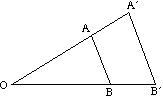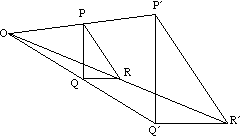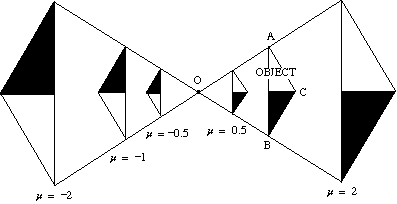An enlargement is a transformation where an object maps to an image of the same shape but different size. The object and the image are said to be similar. An enlargement requires a centre of enlargement and a scale factor.
Notation
E is an enlargement, with centre of enlargement O and scale factor µ.
E: AB ![]() A´B´
A´B´
![]()
Properties of Enlargement
Triangle PQR maps to triangle P´Q´R´ under enlargement with centre O.

Lines and their images are always parallel.
e.g. PQ is parallel to P´Q´
Angle size is invariant.
e.g.
PQR =
P´Q´R´
The centre of enlargement is the only invariant point.
Length and area are not invariant, except when m = 1 or − 1.
Enlargement is a direct transformation.
i.e.
PQR and
P´Q´R´ are both anti-clockwise.
If μ is the scale factor for length, mμ 2 is the scale factor for area.
Different Scale Factors
The diagram below shows the effect of a variety of scale factors on the enlargement of a triangle ABC about centre O.

- If the scale factor is positive, both the object and the image are on the same side of the centre.
- If the scale factor is negative, the object and the image are on opposite sides of the centre.
The image is inverted.
See examples of enlargements − ![]()
Location of the Centre of Enlargement
Given a figure and its image, to find the centre of enlargement:
1. Join up a point and its image.
2. Repeat for another point and its image.
3. The centre of enlargement is the intersection of these lines.
Similar Figures
Figures are similar if they have the same shape.
- Similar figures can be mapped onto one another by an enlargement or by a combination of reflection, rotation or translation and an enlargement.
- The corresponding angles of similar figures are equal.
- The corresponding sides are proportional to one another.
Type 1
![]() YXZ is similar to
YXZ is similar to ![]() PQM as they have corresponding angles equal.
PQM as they have corresponding angles equal.
|
|
 |
![]() YXZ can be mapped to
YXZ can be mapped to ![]() PQM by a combination of transformations.
PQM by a combination of transformations.
Scale factor = µ = ![]()
Type 2
![]() ABC is similar to
ABC is similar to ![]() ADE because:
ADE because:
|
(DE is parallel to BC) |
 |
![]() ABC can be mapped onto
ABC can be mapped onto ![]() ADE by an enlargement.
ADE by an enlargement.
|
(a) (i) The two triangles A and B are similar. Find p and q. |
(a) (i) For A p = 2 × 10 p = 20 2 x q = 12 q = 6 |
|
(ii) The area of triangle A is 24 units2. |
(ii) Scale factor for area = µ2 = 4 Area of triangle B = 4 x area of triangle A |
|
(b) Find x, if BD is parallel to CE |
(b) For 12x = 8(x + 6) 12x = 8x + 48 4x = 48 x = 12 |
Download an interactive spreadsheet (Microsoft Excel) showing reflections, rotations, translations and enlargements.
(Windows users, right click and "Save target as..." to save the files on your computer.)

